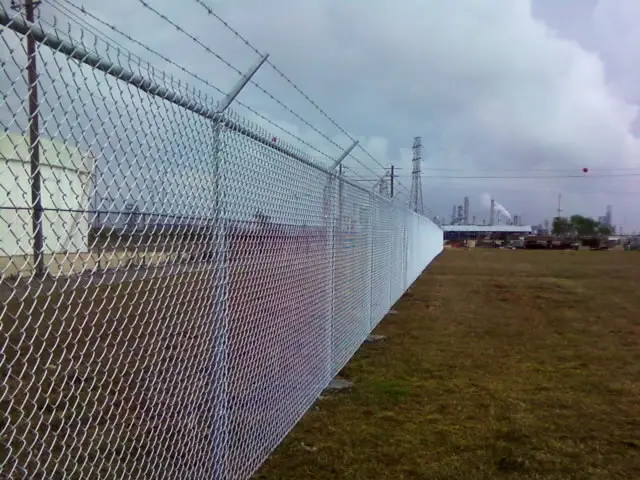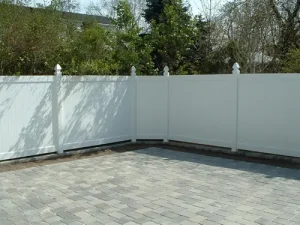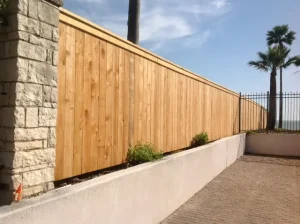![The Great Fence Debate Wood Versus Vinyl [How to Choose]](https://www.dcfence.com/wp-content/uploads/2024/04/The-Great-Fence-Debate-Wood-Versus-Vinyl-How-to-Choose-300x157.webp)
The Great Fence Debate: Wood Versus Vinyl [How to Choose?]
When it comes to enhancing the privacy, security, and aesthetic appeal of your home, few elements play as pivotal a role as your choice of

In a world where security is a growing concern, chain link security fences have emerged as a stalwart guardian, offering a formidable combination of strength and versatility. These unassuming structures, characterized by their related metal links, have long been trusted to safeguard many properties, from residential homes to commercial establishments and industrial sites.
We will explore the various attributes that make chain link security fences an indispensable choice for those seeking reliable protection, exploring their durability, flexibility, and adaptability to diverse environments.
Chain link fences are among the most common for residential and commercial purposes. They consist of a woven mesh made from galvanized steel wire, forming interconnected diamond-shaped patterns. The construction of chain link fences involves securing the wire mesh to steel posts set into the ground, providing stability and support.
These fences are known for their durability and affordability, making them popular for various applications. The materials used in chain link fences typically include galvanized steel wire, which is resistant to rust and corrosion, ensuring a long lifespan even in harsh weather conditions.
With their exceptional strength and durability, chain link fences have earned a well-deserved reputation as a reliable option for enhancing security. Customization options based on gauge and thickness allow for tailored security solutions.
Their galvanized steel composition provides resistance against rust and corrosion, ensuring longevity even in challenging weather conditions. Compared to other fence types, chain link fences offer a cost-effective, low-maintenance option with an extended lifespan.
Chain link fences are known for their strength, durability, and versatility. They consist of galvanized steel wire mesh and offer customization options based on gauge and thickness. These fences are weather-resistant, outlasting other fences, and find applications in residential, commercial, industrial, sports, and educational settings, providing security and boundary delineation. Chain link fences serve as reliable and adaptable solutions for various security needs.
Enhancing security is a crucial role fulfilled by chain link fences, thanks to their specific features and design elements. Chain link fences improve safety through anti-climbing designs and barbed wire or razor ribbon options. Privacy screening and windscreen materials can be added for increased privacy and reduced visibility, boosting overall security. These features reinforce the strength and effectiveness of chain link fences in safeguarding properties and maintaining security.
Customizable chain link fences cater to both functional and aesthetic needs. They can be coated with various colors to blend harmoniously with the surrounding environment or match specific design schemes. Additionally, cosmetic enhancements, such as decorative post caps or gates, can elevate the fence’s visual appeal.
Moreover, chain link fences can be integrated into landscape design by incorporating climbing plants or vines, providing a natural and attractive barrier. These customization possibilities allow for a customized and visually pleasing security solution that complements the property’s overall aesthetics.
Installing a chain link fence can provide your property security and peace of mind. While the process may seem daunting, following a step-by-step guide can simplify the installation and ensure a successful outcome.
Maintaining a chain link fence is crucial for its longevity and effectiveness. Regularly inspect and clean the fence to remove debris and dirt. Promptly address any repairs, such as bent sections or damaged parts. Apply a rust-resistant coating to prevent corrosion and remove vegetation from the fence to avoid moisture buildup. By following these maintenance practices, you can ensure a durable and secure chain link fence.
A cost analysis is essential to understand the financial implications when considering a chain link fence. Material expenses play a significant role, with factors such as the length of the fence, gauge and thickness of the wire, and any additional features influencing the overall cost. Installation costs can vary based on the project’s complexity, including terrain, access, and the need for professional assistance. Additionally, long-term maintenance considerations, such as repairs, coatings, and cleaning, should be factored into the cost analysis.
Chain link fences have notable eco-friendly aspects that contribute to sustainable practices. These fences are typically made from recyclable materials, such as galvanized steel wire, which can be reused or repurposed at the end of their lifespan. Additionally, many manufacturers prioritize sustainable manufacturing practices, including using energy-efficient processes and reducing waste and emissions.
Chain link fences can offer notable benefits in reducing noise pollution. While they may not provide soundproofing, their design, and materials contribute to sound-dampening properties. Opting for a taller and denser chain link fence can further enhance noise reduction capabilities.
Combining the chain link fence with additional sound-absorbing elements, such as vegetation or acoustic panels, can create a more effective barrier against unwanted noise. Considerations of appropriate fence design and other components can significantly contribute to reducing noise levels and improving the overall comfort of your property.
Before installing a chain link fence, it’s crucial to be aware of the legal regulations and permits that may be required. You want to be sure that you comply with specific requirements, such as setback distances, height limitations, and any additional guidelines for fence installation.
Also, homeowners’ associations may have rules and regulations you should follow. So, research the necessary permits and approvals to ensure you comply with all relevant regulations and guidelines. This process gives you peace of mind and saves you from legal hassles.
Comparing chain link fences with choices is helpful when evaluating security fencing options. Wrought iron fences offer a visually appealing and durable option but tend to be more expensive. Wood fences provide privacy and a natural aesthetic but require regular maintenance and may not offer the same level of durability.
Vinyl fences are low-maintenance and resistant to rot and pests, but they can be more expensive upfront. Understanding the pros and cons of each option will assist in selecting the most suitable security fence based on budget, maintenance preferences, and desired aesthetics.
Real-life examples demonstrate the effectiveness of chain-link fences in crime prevention and improving safety. They have successfully secured public parks, playgrounds, construction sites, and educational institutions, deterring vandalism, theft, and unauthorized access. These examples highlight the practicality and impact of chain link fences in creating a safer and more secure environment.
The latest security fence trends involve advanced technology integration and smart fencing solutions. These innovations include sensors, cameras, and remote monitoring systems, providing real-time surveillance and proactive security measures. These advancements enhance the protective capabilities of chain link fences, offering convenient and intelligent security solutions for various applications.
Chain link security fences have proven invaluable assets for those seeking robust and versatile security solutions. With their strength, durability, and customizable features, these fences offer a cost-effective and long-lasting option for safeguarding properties. Whether residential, commercial, or industrial, chain link fences provide peace of mind and reliable defense against unauthorized access.
Contact D & C Fence Co. for professional assistance and high-quality installations if you want to install a chain link security fence. Secure your property confidently with a chain link fence from D & C Fence Co.
By submitting, you agree to receive emails from Uscreen and to our privacy policy.
![The Great Fence Debate Wood Versus Vinyl [How to Choose]](https://www.dcfence.com/wp-content/uploads/2024/04/The-Great-Fence-Debate-Wood-Versus-Vinyl-How-to-Choose-300x157.webp)
When it comes to enhancing the privacy, security, and aesthetic appeal of your home, few elements play as pivotal a role as your choice of

PVC (Polyvinyl Chloride) fencing is a type of synthetic plastic fence that offers a modern alternative to traditional materials like wood and metal. Distinguished by

Wood fences are one of the most traditional and versatile types of fencing used to delineate property lines, enhance privacy, and contribute to the aesthetic
Complete the form below and a representative will contact you shortly.